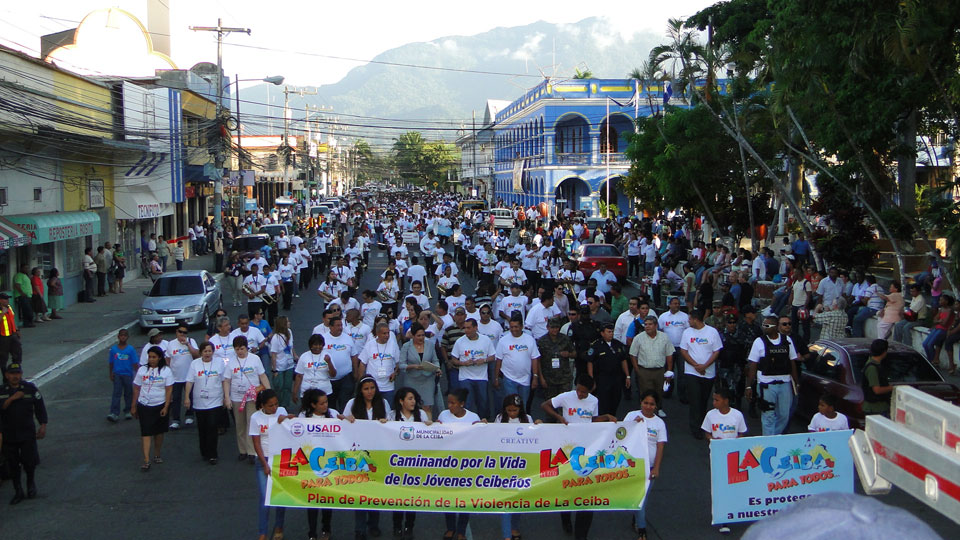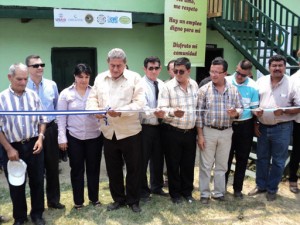HONDURAS:
Outreach Centers, Proactive Prevention and Winning YouthJuly 12, 2011

More than 2,000 marchers display citizen pride in La Ceiba para Todos.
Few roads lead to Puerto Lempira located along the Atlantic coastline about 185 miles northeast of Honduras’s capital city, Tegucigalpa, making it one of the most isolated areas of the country. Accessible only by plane or boat, there are few signs here that indicate globalization has had any trickle-down effect. Paved roads are few; livelihoods remain at a subsistence level and increasing narcotics trafficking in the area make life precarious.
Mostly populated by the Miskito whose spoken language is a mixture of Indian, Spanish, African and English, the area is becoming noticed because of the growth in crime that its proximity to the drug trade route has caused. From a sleepy hamlet where a successful day was marked by a solid meal, Puerto Lempira has become, in the last few months alone, a combat theatre between drug lords with heavy weapons. Not even daylight provides protection from this wave of violence given that assassinations occur in broad day light.
“While in general the homicide rate in Puerto Lempira has been low compared to the rest of Honduras, nowadays there are incidents where bales of drugs wash ashore. The town has seen a recent wave of violence, the situation is clearly deteriorating.” said Salvador Stadthagen, who directs the AJR USAID-SICA project for Creative Associates International, a Washington, D.C.-based international development firm. “There are almost no employment opportunities here and fewer opportunities to gain skills.”
Lack of opportunity and lots of free time are like a pressure cooker for the town’s youth who are increasingly finding an escape in drug use. Those with some familiarity to this part of the Atlantic coastline also say that while couriers used to be paid in cash, they are now being paid with drugs which they in turn sell on the streets of Puerto Lempira.
“We conducted a baseline study in five cities around Honduras and it showed that Puerto Lempira provides the least opportunities for youth to find a job. During the study we assembled some focal groups with youth and found that they have nothing to do and that drug consumptions is spreading and lowering in age,” said Stadthagen. “Drugs are cited as one of the motives of petty robberies, such as stealing bicycles, cooking gas cylinders, clothes from clothesline. They sell these things to buy drugs.”
Largely focused on prevention the AJR USAID-SICA project follows Creative’s carefully crafted philosophical method on how to approach marginalized youth at risk for recruitment into gangs and legal reform on the handling of minors within the legal system. As a result on March 31st, a group of dignitaries, including the President of Honduras himself, Porfirio Lobo Sosa, descended on Puerto Lempira to join residents in witnessing the opening of the town’s first youth Outreach Center. The presence of President Lobo Sosa, along with the U.S. ambassador to Honduras Hugo Llorens, Cardinal Oscar Andres Rodriguez and the ministers FHIS Nasry Asfura and Education Alejandro Ventura, respectively, underscored the authorities’ concern for the community’s welfare.
“We [AJR USAID-SICA] are providing the first free computer training that has ever been offered in the city, and a silk-screen printing workshop for which we just trained 60 youths,” said Stadthagen, after celebrating the opening of the Outreach Center which has been dubbed Brotes Nuevos, or New Sprout, by the community. “They are already selling silk-screened T-shirts. We will also provide training in welding and electricity.”
The Outreach Center concept was first developed under the USAID Youth Alliance Program in Guatemala in 2006, and has now expanded to El Salvador and Honduras through the AJR USAID-SICA program. The Centers are the result of more than five years of effort by Creative to provide substantive prevention measures to reduce vulnerability to crime and gang recruitment for youth in impoverished and often violent neighborhoods in El Salvador, Guatemala and Honduras.
 |
| Opening of Outreach Center in La Amistad, Choloma. |
By the end of June 2011, Outreach Centers in El Salvador, Guatemala and Honduras will number 61, providing thousands of children and youth with a refuge that not only provides entertainment but also a place to do homework and to obtain basic skills and vocational training. In Honduras, alone, more than 4,000 youth from the country’s most violent neighborhoods attend and participate in the Centers’ activities nationwide.
The Brotes Nuevos Center received eight computers from AJR USAID-SICA on its opening day. Showing the growing government interest in the area, President Lobo complemented his visit with an additional donation of another eight computers. Forty-seven beneficiaries are already being trained in the first free of charge computer training center in the city.
Philosophically and practically proactive rather than reactive, the Outreach Center model is particularly critical to Honduras, as in Guatemala and El Salvador, where homicide rates are among the highest in the world due to a large youth population with limited education who lives in violent neighborhoods and are prey to gang recruitment. Over the years, various governments have tried to pacify an alarmed citizenry by insisting that the mano dura – hard hand – policy would be effective in curbing crime rates and gang activity.
But, years of analyzing the reasons impoverished youths in some Central American countries fall prey to gangs and other criminal activities by Creative experts, Harold Sibaja and Salvador Stadthagen have concluded that the only way to stem the tide of youths lost to the streets is to provide proactive options that help to structure and guide them as they face tough life decisions. According to Sibaja, the intent of the Centers and the overall youth campaign is to develop new leadership that promotes a culture of life in contrast to the culture of death that reigns in many of these communities.
“We are also financing an anti-drug consumption prevention campaign in collaboration with the government of Honduras which will include radio spots on the Catholic Church’s radio station utilizing a Miskito boy and girl as characters,” said Stadthagen. “The campaign will include posters, T-shirts and school presentations. The drawings for the T-shirts are going to be made by the New Sprout Center’s micro-enterprise.”
Not only do the Centers provide a safe haven for youth which include training in various trades, they are also a low-cost sustainable alternative and rely primarily on community volunteers with only the coordinator of the Center being a staff member. Accordingly, more than three thousand young people and hundreds of volunteers are already part of the Outreach Center effort in the three countries. For Puerto Lempira which is also the capital of the Gracias a Dios (Thanks be to God) Department of Honduras, perhaps a new day is dawning for its youth, one with opportunity to pursue aspirations that will trickle-down to the next generation.
